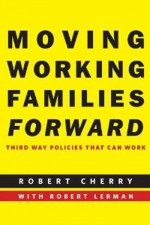
In Squaring Off, Zócalo invites authors into the public square to answer five questions about the essence of their books. For this round, we pose questions to Brooklyn College economist Robert Cherry, co-author of Moving Working Families Forward: Third Way Policies That Can Work.
Cherry and co-author Robert Lerman argue that “the Third Way”-an intermediate position between Republicans and Democrats-holds the answer to a lot of America’s political dysfunction. Based on studies as well as conversations with working-class families, they propose policies that are not hemmed in by ideology but propelled by pragmatism.
1) President Obama’s attempts at working across the political aisle and pursuing a moderate path have generally failed. How could a president elected in 2012 possibly enact a “Third Way” policy?
 President Obama has often sought compromise by taking liberal policies and packaging them with conservative policies. By contrast, Moving Working Families Forward advocates individual policies that combine the compassion of liberals with concerns for efficiency and personal responsibility, similar to President Clinton’s Make Work Pay policies. In each of the areas discussed-immigration, housing, racial and gender disparities, federal taxation, community colleges, and family formation-Moving Working Families Forward offers workable policies that take seriously the unintended consequences that conservatives use to criticize many well-intentioned liberal policies but also seek out effective ways to give support to struggling families that cannot move forward with government support. This is why the book has been praised by a leader at the liberal Institute for Women’s Policy Research, a visiting scholar at the conservative American Enterprise Institute, and a former acting deputy director of the OMB in the Obama Administration.
President Obama has often sought compromise by taking liberal policies and packaging them with conservative policies. By contrast, Moving Working Families Forward advocates individual policies that combine the compassion of liberals with concerns for efficiency and personal responsibility, similar to President Clinton’s Make Work Pay policies. In each of the areas discussed-immigration, housing, racial and gender disparities, federal taxation, community colleges, and family formation-Moving Working Families Forward offers workable policies that take seriously the unintended consequences that conservatives use to criticize many well-intentioned liberal policies but also seek out effective ways to give support to struggling families that cannot move forward with government support. This is why the book has been praised by a leader at the liberal Institute for Women’s Policy Research, a visiting scholar at the conservative American Enterprise Institute, and a former acting deputy director of the OMB in the Obama Administration.
2) You argue that we should implement policies that encourage marriage, because marriage decreases the number of children raised in poverty. How can we implement these policies without coercion or discrimination?
Of course, we should be more supportive of single mothers and the Third Way includes a number of policies to aid them. For example, by making a small change in state regulations, mothers could gain substantially more federal child care subsidies by shifting to pre-tax dependent care accounts; reducing the phase-out of earned income tax benefits will enable them to keep more of their wage gains. We should not, however, ignore research that shows clear benefits to children raised in two-parent households. The government should find ways to combat the fragile families that are much too prevalent today. The phasing out of government benefits as family income rises creates disincentives to marry. Thus, Moving Working Families Forward recommends tax policies to reduce these benefits losses in order to combat government-induced marriage barriers single mothers currently face.
3) You discuss the importance of decreasing earning disparities for minorities and women. How does equal pay qualify as a Third Way policy?
 Our approach emphasizes initiatives other than combating discriminatory behavior. Racial earnings disparities could be reduced by weakening the use of social networks when making hiring decisions and promoting effective hiring practices, including appropriate testing procedures, evaluation of credentials, and interviewing policies. Many disadvantaged youth would benefit more from schooling that taught the soft skills crucial for employability rather than requiring Algebra II. Schools should offer more occupational tracks that are linked to community college associates programs rather than focusing solely on four-year college goals. To lessen gender disparities, we propose redirecting manpower training programs to enable more women to enter male dominated professions, particularly those like IT that stress technological competence; expanded child care policies that would enable women to work the longer hours typical of these male-dominated occupations; and policies to enhance pay scales and benefits in female-dominated occupations.
Our approach emphasizes initiatives other than combating discriminatory behavior. Racial earnings disparities could be reduced by weakening the use of social networks when making hiring decisions and promoting effective hiring practices, including appropriate testing procedures, evaluation of credentials, and interviewing policies. Many disadvantaged youth would benefit more from schooling that taught the soft skills crucial for employability rather than requiring Algebra II. Schools should offer more occupational tracks that are linked to community college associates programs rather than focusing solely on four-year college goals. To lessen gender disparities, we propose redirecting manpower training programs to enable more women to enter male dominated professions, particularly those like IT that stress technological competence; expanded child care policies that would enable women to work the longer hours typical of these male-dominated occupations; and policies to enhance pay scales and benefits in female-dominated occupations.
4) But don’t community college occupational tracks rob students of the well-rounded education that a four-year university offers?
Given the weak academic skills of many students entering community colleges, and given their very low college graduation rates, directing them into certification and two-year occupational programs may be the best way for them to move forward. Indeed, studies have shown that at-risk students in high school and college occupational programs go at least as far in the education system as similar students in purely academic tracks.
There is also a harmful unintended consequence of community colleges minimizing their occupational offerings: it drives at-risk students into for-profit colleges where they are vulnerable to unsavory practices. Two-year occupational degrees are increasingly valuable. About 60 percent of those with two-year degrees earn more than the lowest-paid 25 percent of four-year graduates. Thus, even many students who squeak through with four-year degrees will have lower lifetime earnings than if they had been directed into two-year programs.
5) You argue that the number of undocumented students who can enroll in American universities under the DREAM Act should be limited annually. Is there a way to do this fairly?
While Moving Working Families Forward supports the DREAM Act on humanitarian grounds, it documents the adverse consequences that less-educated immigrants have had on American society. They have lowered the employment of less-educated native-born workers and are partially responsible for the halving of teen employment rates in the last decade. Just as importantly, less-educated immigrants pay little federal or state income taxes, but reap substantial benefits from government safety net programs. More troubling, the children of less-educated immigrants are not moving forward despite their utilization of substantial Title 1 and other school resources. As a result, the DREAM Act creates the real possibility that even more ill-prepared students will enter community colleges that don’t have the resources to effectively handle the other weakly prepared entering students. Thus, if the DREAM Act passes, the federal government must provide additional resources or colleges should reduce the number of other non-resident students they enroll.
Buy the book: Skylight, Powell’s, Amazon.
*Photo courtesy of nh-08.



